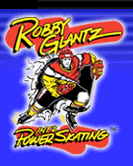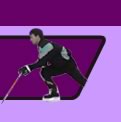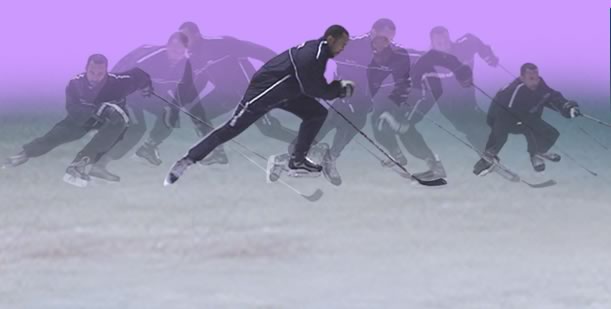Skating Imagery II
In last month's edition we gave a first glance of our ideas on how to use "skating imagery" to improve your play. The goal of learning skating imagery is to get you to a point where you can practice skating on your own and be able to draw pictures in your mind of what you are doing both right and wrong. These mental images will make it much easier for you to remember more of the details of powerful skating; and retention is the key to improvement.
In this month's edition we will help you to better understand what you should be thinking about while performing many of the skating maneuvers needed to make you a consistently good skater and in turn a much more effective hockey player (both on ice and rollers). The format is set up as a checklist in the order that we have found to be the most successful for retaining the key points; however, if you find it easier to remember the information in another manner by all means do so - Our Power Skating Program prides itself on flexibility, we are constantly experimenting with new ideas and technologies at our schools/clinics as we are only interested in one thing, the improvement of our students!
FORWARD STRIDE
Key Points:
• Start with your skates forming a "V" or "Arrow Tip" position (heels together), knees turned outward
• Bend your knees so you cannot see your toes
• Roll your inside edges half way to the ice
• Push one foot at a time putting 100% body-weight in each stride
• Aim your push perpendicular to (directly against) the inside edge
• Finish your stride at the toe of the skate with your knee turned out
• Extend the leg until it locks (full extension), and then rapidly and fully return the leg back to the "Arrow Tip" position so you may start each stride from under your body for maximum power
• Keep your feet very low to the ice at all stages of the stride
Skating Imagery:
Picture that you have a line or divider that goes down the center of your body separating it into two halves; and imagine that the right and left sides act independently of the other, each, with its own individual job to get you maximum power on every stride. Playing this mental game should help you to get that feeling of using one foot at a time. Also, in the case of the forward stride one foot pushes while the other glides.
BACKWARD STRIDE
Key Points:
• Bend your knees deeply, again, so that they are covering your toes
• The back is straight, head is up and eyes are forward
• Start each push from directly under your body
• Pivot the pushing foot so that the heel turns out
• Push one foot at a time using all your weight on each thrust
• The pushing foot drives to the side to full extension forming a "Half-Moon (C)" in the ice while you glide on the other foot straight back
• Do not swivel your hips like you are dancing, maintain directness
Skating Imagery:
When skating backwards your body posture and positioning are vital. You should feel like you are sitting on a stool with your behind almost parallel to the ice, keeping your back straight and your weight centered directly over the middle of your skates. Positioning your upper body and chest too far forward when going backwards will put too much weight to the front part of the skate and definitely take away from your balance, speed and power.
FORWARD CROSSUNDERS
Key Points:
• Once again, bend those knees
• Your inside foot MUST land on an outside edge half way to the ice
• Keep your weight centered over your skates and your shoulders parallel to the ice
• Focus on getting power from both legs
• The outside foot pushes from an inside edge to full extension and the inside foot then pulls from an outside edge also to full extension.
• Try to form a "Big Y" with your legs to create powerful crossunders
• Keep your feet low to the ice
• Do not run on your skates, maintain a nice, even flow
Skating Imagery:
Try to think of crossovers as "crossunders." So many players from novice to pro are under the misguided idea that they need lift their outside foot very high off the ice so they can cross it "over." Instead, you should concentrate on keeping your feet very low to the ice pulling the inside leg under the body to achieve better fluidity, speed and balance when performing corners.
IT'S A LOT TO THINK ABOUT
Do not worry about remembering everything. Pick the key points that you feel will most improve your skating and work those skills the hardest. Take your time when practicing and try not to compare yourself to your peer's progress, as we all have a different learning curve.
Finally, when I'm teaching I often like to tap our younger players on the helmet to remind them that skating (and all aspects of hockey for that matter) starts in their head and then transfers to the leg. And this is applicable and important for all ages and levels to "think first" and "do second."





